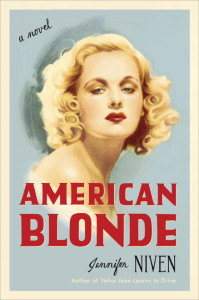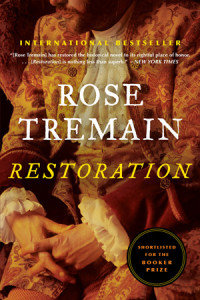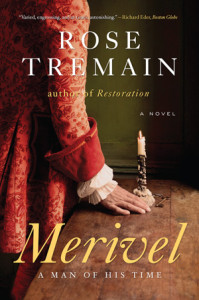 THE “OLD HOLLYWOOD” STUDIO SYSTEM AND THE MAKING OF A MOVIE STAR (1945-1947): Jennifer Niven’s American Blonde is like a walk down memory lane. You can almost see and hear Judy Garland singing, Fred Astaire dancing, Clark Gable acting. The author is in love with the Old Hollywood of the ‘30s and ‘40s when a big-league film studio like “Metro” (“sixty stars, the most of any studio. More stars than in heaven”) made stars bigger than life. Niven, whose name has a stardom ring to it, has an emotional attachment to those bygone days, which you’ll learn about in the last enlightening chapter, “Endings.” From what I gather, she’s waited a long time to craft a wistful Hollywood story she was meant to write, steeped into nostalgic details, for this is her fourth novel starring her beautiful, spirited country girl from Appalachia, Velva Jean.
THE “OLD HOLLYWOOD” STUDIO SYSTEM AND THE MAKING OF A MOVIE STAR (1945-1947): Jennifer Niven’s American Blonde is like a walk down memory lane. You can almost see and hear Judy Garland singing, Fred Astaire dancing, Clark Gable acting. The author is in love with the Old Hollywood of the ‘30s and ‘40s when a big-league film studio like “Metro” (“sixty stars, the most of any studio. More stars than in heaven”) made stars bigger than life. Niven, whose name has a stardom ring to it, has an emotional attachment to those bygone days, which you’ll learn about in the last enlightening chapter, “Endings.” From what I gather, she’s waited a long time to craft a wistful Hollywood story she was meant to write, steeped into nostalgic details, for this is her fourth novel starring her beautiful, spirited country girl from Appalachia, Velva Jean.
Velva Jean heartens us, the way she keeps re-inventing herself. In this novel, she’s Kit Rogers, Hollywood’s newest sensation. If, like me, you start with American Blonde, you can always go back to what you missed as she comes of age in Velva Jean Learns to Drive, Velva Jean Learns to Fly, Becoming Clementine – the “Velva Jean Series.” This novel can stand alone, as it fills you in on the earlier trio: Married at 16, divorced by 20 (DRIVE); Velva Jean heads to Nashville pursuing her passion, singing. When that doesn’t work out, her brother, Johnny Clay Hart, inspires her to pursue flying, as a WASP or Women’s Airforce Service Pilot (FLY), which leads to her becoming a spy and a WWII heroine (CLEMENTINE).
Returning to America, “Miss Red, White, and Blue,” poses for a newsreel featuring the “second girl in history to fly a bobber across the ocean.” A blonde, green-eyed “natural beauty,” Velva Jean catches the cinematic eyes behind Metro-Goldwyn-Meyer, like its legendary head, Louis B. Mayer, who at 60, “didn’t look at all like the most powerful man in Hollywood.” Now Kit Rogers, her transformation feels as glamorous as the novel’s alluring cover but Velva Jean confides she “had her own scars but I wasn’t wearing them on the outside.”
At 24, Kit Rogers still dreams of Nashville. She reasons that coming to Hollywood she’ll “train with the finest music teachers in the world,” so when she returns to her southern roots she’ll take them by storm. She’s right: she’s seriously trained in singing, and so much more.
Kit’s first film role is a revolutionary war hit, “Home of the Brave,” on Stage 15, “the largest in the world.” She plays Betsy Ross, a “patriotic Cinderella,” a role created just for her. Here we meet a full cast of Hollywood characters – actors, actresses, producer, director, agent, photographer, publicists, gossip columnist, costume designer, drama teacher, voice teacher, general manager – so many as you’d expect for the mighty studio. A couple of characters besides Kit loom large: The screenwriter, Sam Weldon, one of two men who sweeten the novel’s romantic tension; and Barbara Jenning, formerly Eloise Mudge, one of Velva Jean’s closest friends going back to their flying days, now an actress in the picture too, whose having an affair with the film’s hottest star, handsome Nigel Gray, a married man.
Since Velva Jean tells us she’s spent her life fighting, Niven plots another cause for her to fight, turning her charming historical novel into a mystery. Like her honorable character, she’s not afraid to shine a light on an all-powerful studio system that didn’t just make stars, but could break them.
What I especially relished about the novel is the tender prose. The author stays true to the integrity of her Velva Jean character even in Hollywood. Romance and mystery can still be delivered up in the juicy, wholesome spirit of the golden era of Hollywood. So, the mystery feels like you’re watching Perry Mason sleuthing and the romance is sweet and sexy but left to your imagination. Take this witty, suggestive banter between Sam and Kit, whom he affectionately calls “Pipes”:
Sam: “You’re not the kind men mess with.”
Sam: “For you, Pipes, I’d steal the moon.”
Sam: “I like holding hands with you Pipes. I don’t know when holding hands has ever excited me more. Or at all.”
Kit: “I can’t imagine you do a lot of hand holding.”
Sam: “No, but I can imagine doing a lot of it with you.”
Sam, like Kit’s adoring fans, is dazzled by her. So is Butch Dawkins. Not to the new Kit Rogers, but to the old Velva Jean he met five years ago when they trained at Camp Davis. (Here, for instance, I wanted the backdrop.) Butch, part Creole, part Choctaw, plays the guitar in a band with Kit’s brother Johnny Clay. They’ve come to LA to record soulful songs. Velva Jean may be flirtatious around polished Sam, but it’s the virile, non-polished Butch who “didn’t smile a lot but when he did he was the best-looking man I’d ever seen,” that Velva Jean/Kit Rogers can’t seem to forget. Butch remembers too, but he’s a serious, compassionate, patient, no-nonsense guy. Yes, you really can feel the electricity between these two. MGM may have succeeded in training Kit to sing pop, jazz, and vocal without her southern cadence, but it’s Butch who warns her “they’re going to rub the shine right out of you.”
His words are prophetic. When Kit first breathes in California, she tells herself “all the world was right here at Metro-Goldwyn-Meyer.” But then a tragedy unfolds. If you read the back cover, you’ll know that Kit’s best friend Mudge has suddenly died at a party for the cast and crew of “Home on the Brave” at the Santa Monica estate of the film’s producer, Billy Taub, and his brought-out-of-retirement for this film, celebrity wife, Ophelia Lloyd. Now Kit Rogers finds herself in a “world where nothing was what it seemed.”
Yet Kit Rogers is still that brave girl who escaped a concentration camp and rescued her brother, Johnny. (Another instance when I missed the earlier novels.) For American Blonde is filled with suspense, pressures, and threats but our heroine is undaunted, determined to solve what’s really happened to her friend – which she does.
When Kit sings the apt-titled song “Facing the World Alone” in her next “Flyin’ Jenny” film, you can envision sitting in the audience clapping your hands. For you too are won over by this principled, old-fashioned character who sends us a big-hearted, modern-day message about hope and love and friendship and truth.
My hope is that the film rights to American Blonde are bought by MGM, so that fiction and truth merge when I’m really in the audience clapping. Lorraine




 The review is a double-package. Merivel is the sequel to Restoration, originally published in the UK in 1989, and nominated for the Man Booker Prize. I read both to see how well Merivel stands by itself. While it does (many times the reader is brought up-to-speed), you may feel greater compassion for Merivel having seen how far he’s come if you read both.
The review is a double-package. Merivel is the sequel to Restoration, originally published in the UK in 1989, and nominated for the Man Booker Prize. I read both to see how well Merivel stands by itself. While it does (many times the reader is brought up-to-speed), you may feel greater compassion for Merivel having seen how far he’s come if you read both.